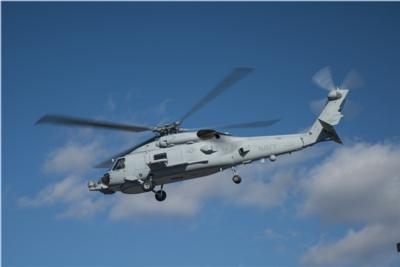Mon, Nov 17, 2014
MH-60R Sub Hunters Have Flown More Than 250,000 Hours
The U.S. Navy received its 200th submarine-hunting MH-60R "Romeo" helicopter from Lockheed Martin following a patch signing with Helicopter Maritime Strike Squadron Seven-Two (HSM-72). The cornerstone of the U.S. Navy's anti-surface and anti-submarine operations, MH-60R helicopters have flown more than 250,000 hours in operation with the Fleet, providing increased surveillance and situational awareness.

"We are proud to continue supporting the U.S. Navy by delivering a multi-role aircraft with a game-changing sensor suite that shifts the advantage from the submarine to the helicopter," said Dan Spoor, vice president of Aviation and Unmanned Systems for Lockheed Martin's Mission Systems and Training business. "As surface and submarine warfare becomes increasingly complex, the MH-60R's capabilities are unmatched in identifying, locating, tracking and prosecuting these threats."
Manufactured by Sikorsky Aircraft Corp and provided with advanced mission systems and sensors by Lockheed Martin, the MH-60R employs a modular design, which refers to the ability to modify weapon systems to match specific mission requirements. The modularity gives this single platform the agility to provide greater surveillance and flexibility to the Fleet, tailored for the mission. Aboard the MH-60R, sensor data is integrated into actionable information for the three-member crew. The mission systems compile data from onboard and offboard sensors to create an integrated picture that enhances decision-making.
Secondary missions include search and rescue, vertical replenishment, naval surface fire support, logistics support, personnel transport, medical evacuation, and very high frequency, ultra high frequency link communication relay.
The U.S. Navy is projected to acquire 291 MH-60R helicopters. The Lockheed Martin-Sikorsky team has also delivered five of 24 aircraft to the Royal Australian Navy and began production for the Royal Danish Navy, which will acquire nine aircraft.
(Image provided by Lockheed Martin)
More News
Airport Marking Aids Markings used on runway and taxiway surfaces to identify a specific runway, a runway threshold, a centerline, a hold line, etc. A runway should be marked in ac>[...]
"It is extremely difficult, if not impossible, for manned aircraft to see a drone while conducting crop-enhancing and other aerial applications at low altitudes and high speeds. We>[...]
Aero Linx: The Skyhawk Association The Skyhawk Association is a non-profit organization founded by former Skyhawk Pilots which is open to anyone with an affinity for the A-4 Skyhaw>[...]
“The T-54A benefits from an active Beechcraft King Air assembly line in Wichita, Kansas, where all required METS avionics and interior modifications are installed on the line>[...]
Aero Linx: Aerostar Owners Association The Association offers the Aerostar Owner a unique opportunity to tap an invaluable source of information concerning the care and feeding of >[...]
 ANN's Daily Aero-Term (04.28.24): Airport Marking Aids
ANN's Daily Aero-Term (04.28.24): Airport Marking Aids Aero-News: Quote of the Day (04.28.24)
Aero-News: Quote of the Day (04.28.24) ANN's Daily Aero-Linx (04.28.24)
ANN's Daily Aero-Linx (04.28.24) Aero-News: Quote of the Day (04.29.24)
Aero-News: Quote of the Day (04.29.24) ANN's Daily Aero-Linx (04.29.24)
ANN's Daily Aero-Linx (04.29.24)



